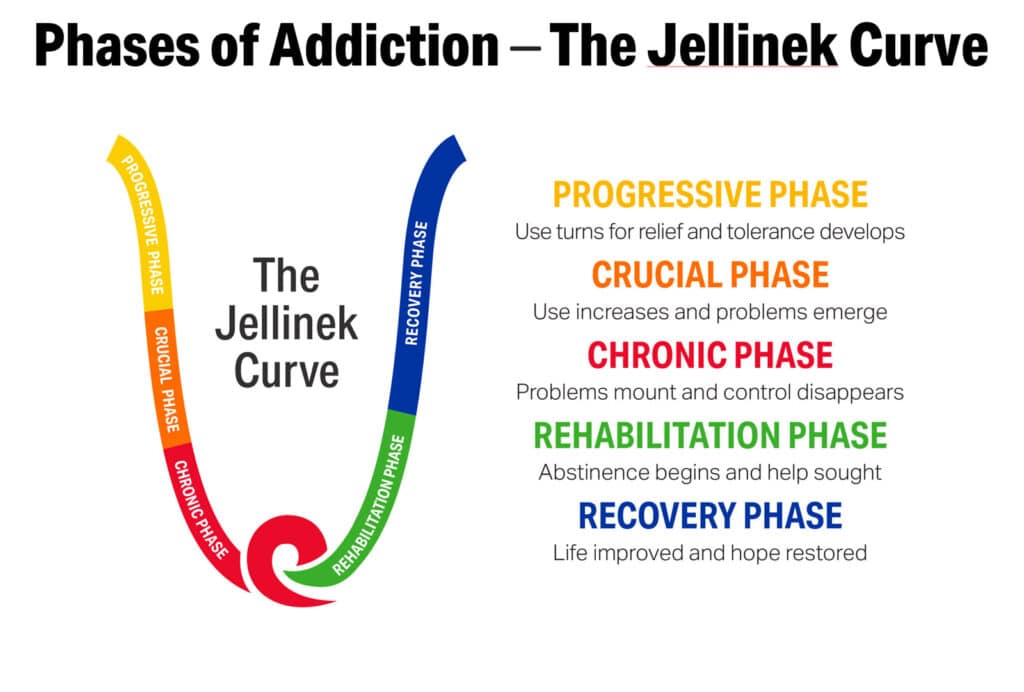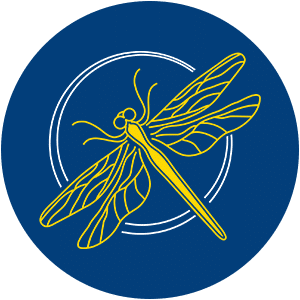Alcoholism is a serious medical condition and is one of the most common addictions worldwide. While each person experiences it differently, there are some typical phases of alcohol addiction and recovery that many people go through, as shown and described by the Jellinek Curve.
Understanding this visual tool can help you or your loved ones spot the early signs of alcoholism, break the destructive cycle of addiction, and let go of obsessive drinking behaviors in favor of a healthier, happier life.
Table of Contents
What Is the Jellinek Curve?
The Jellinek Curve, named after American alcohol researcher, Dr. Elvin Morton Jellinek, is a U-shaped chart that describes the common phases of alcohol addiction and recovery. It lists the specific symptoms of each stage and illustrates how alcoholism progresses for most individuals.

The chart also shows how obsessive drinking can turn into a vicious cycle that repeats until the person breaks free and seeks help. Although the Jellinek Curve was originally created to explain the trajectory of alcoholism, it has since been applied to many other types of addiction.
Origin of the Jellinek Curve
The Jellinek Curve is based on the work of Dr. Elvin Morton Jellinek, one of the founders of modern addiction science. In the 1940s, as part of his research, he surveyed thousands of people suffering from alcohol addiction about their personal experiences.
After analyzing the results of his surveys, Dr. Jellinek identified significant behavioral patterns and used them to define the phases of alcohol addiction. His findings also proved to him that alcoholism wasn’t a moral shortcoming, but a disease, which revolutionized its treatment.
The Jellinek Curve was first introduced in the Quarterly Journal of Studies on Alcohol and Drugs. Dr. Max Glatt, a German British psychiatrist and addiction expert, further refined the chart, by adding his findings about the shared experiences of his patients in recovery.

Understanding the Jellinek Curve: 5 Phases of Alcoholism
According to E.M. Jellinek and M. Glatt, people who are addicted to alcohol tend to go through the following progressive phases:
1. Pre-Alcoholic Phase
In the first phase of the Jellinek curve, a person uses alcohol to relax, relieve stress, or cope with mental health problems, like depression and anxiety. They may be drinking to feel better about themselves and to forget any emotional or physical pain they’re experiencing.
This phase is sometimes called “early relief drinking” or “gray area drinking.” It can be the hardest to spot since alcohol consumption is considered normal for many, and binge drinking can be a common activity for some during the weekends, at parties, and other celebrations.
At this point, the person can still function without alcohol throughout the day. They don’t experience any negative consequences from drinking, and there are no signs of physical dependence. However, repeated use can lead to tolerance.
Eventually, the person may need to drink more than before to feel the same effects. Instead of developing healthy coping mechanisms, they start to rely on alcohol to deal with their emotions.
2. Prodromal Phase (Early Alcoholic Stage)
When a person enters the prodromal phase, also known as the early alcoholic stage, the amount of alcohol they consume and how often they drink increases. Occasional nights out can turn into regular binge sessions. Experiencing blackouts is a warning sign of this phase.
In addition to thinking obsessively about drinking, many people will feel guilty about their cravings at this stage, so they may attempt to hide their drinking patterns. They begin to feel an impact from their alcohol use, such as sleep troubles, poor judgment, and relationship problems.
The person may also neglect their personal and professional life, and have a hard time fulfilling home, school, or work responsibilities because of hangovers.
Some of the troubling signs and symptoms of the prodromal phase include:
- Frequent weekday drinking
- Drinking to sleep or to intoxication
- Refusing to talk seriously about drinking habits
- Driving under the influence (DUI)
- Nausea, headaches, or poor memory from drinking
3. Crucial Phase (Middle Alcoholic Stage)
The crucial phase is characterized by a person’s loss of control over their alcohol consumption. In most cases, the individual is completely dependent on alcohol, and can even start drinking in the morning. They often try to rationalize their behavior, make excuses, or isolate themselves.
During this phase, the damage of drinking is evident to the person’s friends and family. Their physical health declines and hospital trips may be common. Signs of alcohol abuse include facial redness, stomach bloating, weight gain or loss, mood swings, and sluggishness.
The person struggling with alcohol may also lose interest in their work, education, hobbies, and loved ones. As a result, they may encounter relationship, financial, and legal problems. It’s also common for people in this stage to try to stop drinking and to fail repeatedly.
4. Chronic Phase (Late Alcoholic Stage)
At the bottom of the Jellinek curve, there’s a loop where people can get trapped in a vicious cycle of alcohol addiction. It’s called the chronic phase, also known as “end-stage alcoholism.” Drinking becomes an individual’s sole focus, and alcohol is no longer a want but a need.
Their dependence on alcohol has become so high, that stopping may result in serious and life-threatening withdrawal symptoms. To escape the withdrawal patterns, they start drinking again and the cycle continues. They may also get addicted to other harmful substances.
The person’s physical and mental health spiral downward until they hit rock bottom. This may provide a wake-up call for them to seek help and start working toward recovery.
The health effects of long-term heavy drinking at this stage include:
- Liver disease
- Heart failure
- Brain damage
- Aggression and impulsivity
- Hallucinations and paranoia
- Psychotic episodes or mental health disorders
5. Rehabilitation Phase
The road to rehabilitation begins with an honest desire for help. In the final phase of the Jellinek curve, the path steadily turns upward, as the person struggling with alcohol addiction makes an effort to break free from their old patterns and starts their recovery process.
After they stop drinking, symptoms of substance abuse gradually disappear. Foggy thinking clears up and is replaced by hopeful thoughts of a new life. They learn healthy coping mechanisms to deal with cravings and manage stress. Their health stabilizes, and their self-esteem is renewed.
The rehabilitation phase can be long and complicated, requiring lots of time and perseverance. However, the outcome is always worth it. With hard work, the right treatment, and support from loved ones, the person can fully recover into a healthy, happy, and fulfilling life free of addiction.
Signs that someone is in the rehabilitation phase are:
- Improved nutrition, hygiene, and sleep
- New interests and hobbies
- A network of stable and supportive friends
- Stronger emotional control
- Move toward financial, social, and emotional stability

Why Is the Jellinek Curve Important?
The Jellinek Curve serves as a science-backed visual tool that helps people understand the stages of addiction and the path to recovery. It clearly demonstrates how alcoholism can progress from occasional drinking to obsessive binging and addiction if left untreated.
The chart can help patients and loved ones identify whether certain drinking habits are a cause for concern, recognize that recovery is possible, and take action sooner rather than later.
It can also assist addiction treatment professionals in recognizing the early warning signs of addiction and tracking a patient’s journey, which can be helpful for their recovery.
The Jellinek Curve is widely used as an intervention aid in Alcoholics Anonymous (AA), related support groups, and many other addiction treatment programs. It has destigmatized addiction, showing it as a treatable condition with hope for recovery, instead of a personal weakness.
What Are the Treatment Options for Alcohol Use Disorder?
Alcohol addiction is clinically referred to as Alcohol Use Disorder (AUD). Much like many other medical conditions, it can be successfully managed and treated. There are a variety of options to treat AUD, including detoxification, rehab programs, therapy, medication, and support groups.
- Alcohol Detoxification: A medical process that allows an individual to safely and comfortably withdraw from alcohol and cleanse the substance out of their system.
- Addiction Treatment Programs: Inpatient and outpatient alcohol rehab programs offer different levels of care and support in treating AUD, depending on the person’s needs.
- Therapy for Addiction Recovery: Seeing a therapist can help an individual stay sober for the long term by teaching them coping strategies and ways to deal with triggers.
- Peer Support Groups: Support groups offer companionship and shared experiences on coping with AUD, preventing and dealing with relapses, and staying sober.

Chart Your Path to Addiction Recovery Today
The Jellinek Curve visibly illustrates that recovery is always possible no matter what phase of alcoholism a person is in. It serves as a symbol of hope for people struggling with addiction, assuring them that there’s a bright path ahead, and guiding them on the road to recovery.
If you or a loved one is dealing with alcohol use disorder, you can use the Jellinek Curve as a tool to chart your path to a successful recovery and live your life addiction-free. Contact Illinois Recovery Center today to learn how we can be there for you every step of the way.



